January 2025
The global cosmetic antioxidants market size is calculated at USD 162.29 million in 2025 and is forecasted to reach around USD 266.45 million by 2034, accelerating at a CAGR of 5.67% from 2025 to 2034. The Asia Pacific cosmetic antioxidants market size surpassed USD 56.80 million in 2025 and is expanding at a CAGR of 17.37% during the forecast period. The market sizing and forecasts are revenue-based (USD Million/Billion), with 2024 as the base year.
The global cosmetic antioxidants market size was estimated at USD 153.51 million in 2024 and is predicted to increase from USD 162.29 million in 2025 to approximately USD 266.45 million by 2034, expanding at a CAGR of 5.67% from 2025 to 2034.
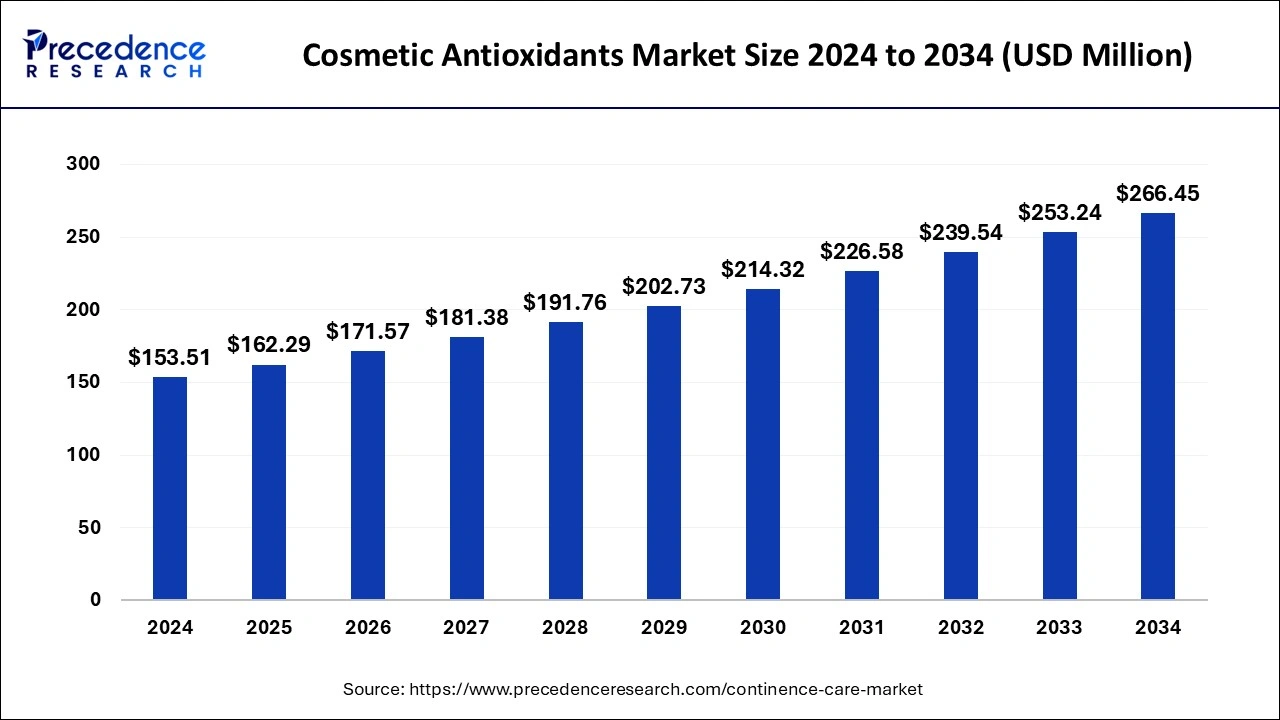
The Asia Pacific cosmetic antioxidants market size was estimated at USD 53.73 million in 2024 and is predicted to be worth around USD 94.59 million by 2034, at a CAGR of 17.37% from 2025 to 2034.
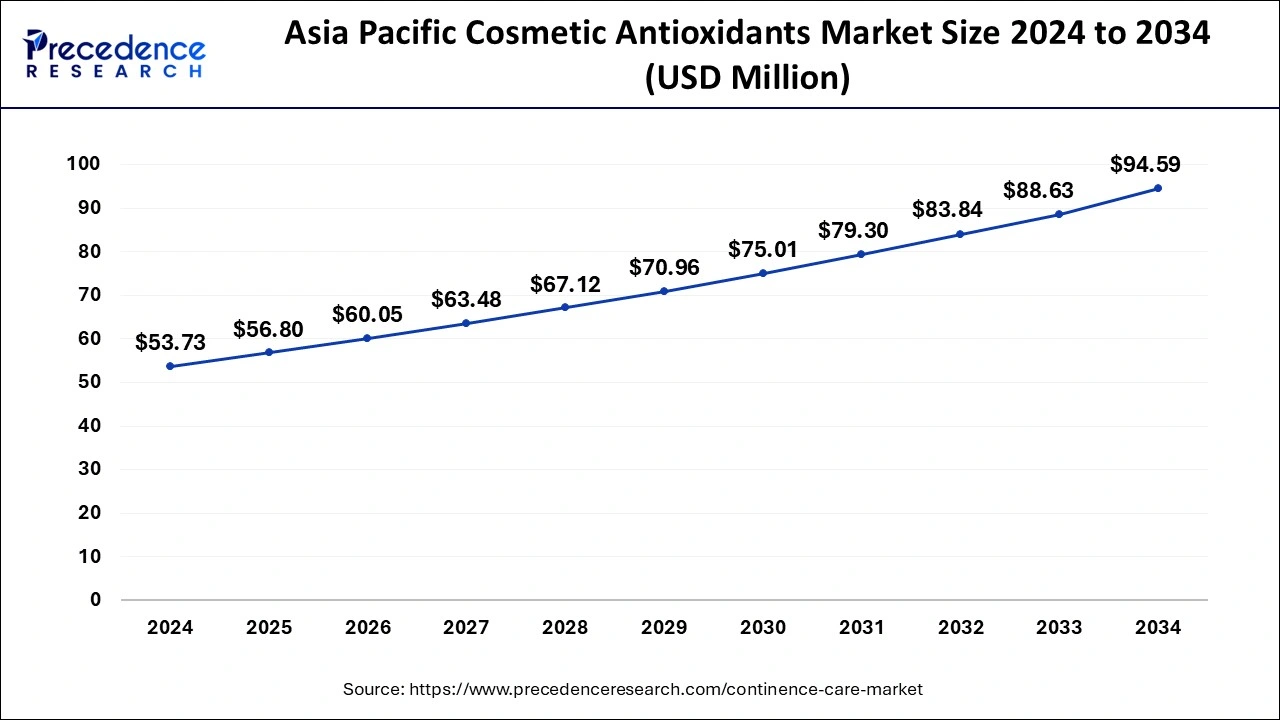
Asia Pacific dominated the cosmetic antioxidants market in 2024. The region’s growth is driven by the presence of prominent market players, a rising population, growing awareness regarding the safety of skincare products, and rising consumer interest concerning appearance, beauty, and appeal. The rising use of cosmetic products to protect skin and hair from the effects of environmental factors like UV and pollution is likely to spur the demand for cosmetic antioxidants.
Countries such as China, India, South Korea, and Japan are the leading countries contributing to the growth of the cosmetic antioxidants market in the region. Due to the rising population's concern for improving the standard of living, rising consumer spending on cosmetic products, and rising engagement in e-commerce activities to purchase cosmetics products, stringent government regulation regarding undesirable or adverse effects of skin care products and increasing government concern about the safety of ingredients used in cosmetic products to safeguard from the harmful effects of free radicals.
Several Indian companies such as Mama Earth, Cipla Limited, Khadi Essential, Biotique, Coloressence, Sugar Cosmetics, and others promote their cosmetics and personal care products to meet the increasing demand in the nation. Furthermore, cosmetics companies use marketing strategies such as new product launches and acquisitions, collaborating with beauty bloggers and influencers, and increasing investment in TV and social media advertising to boost product sales.
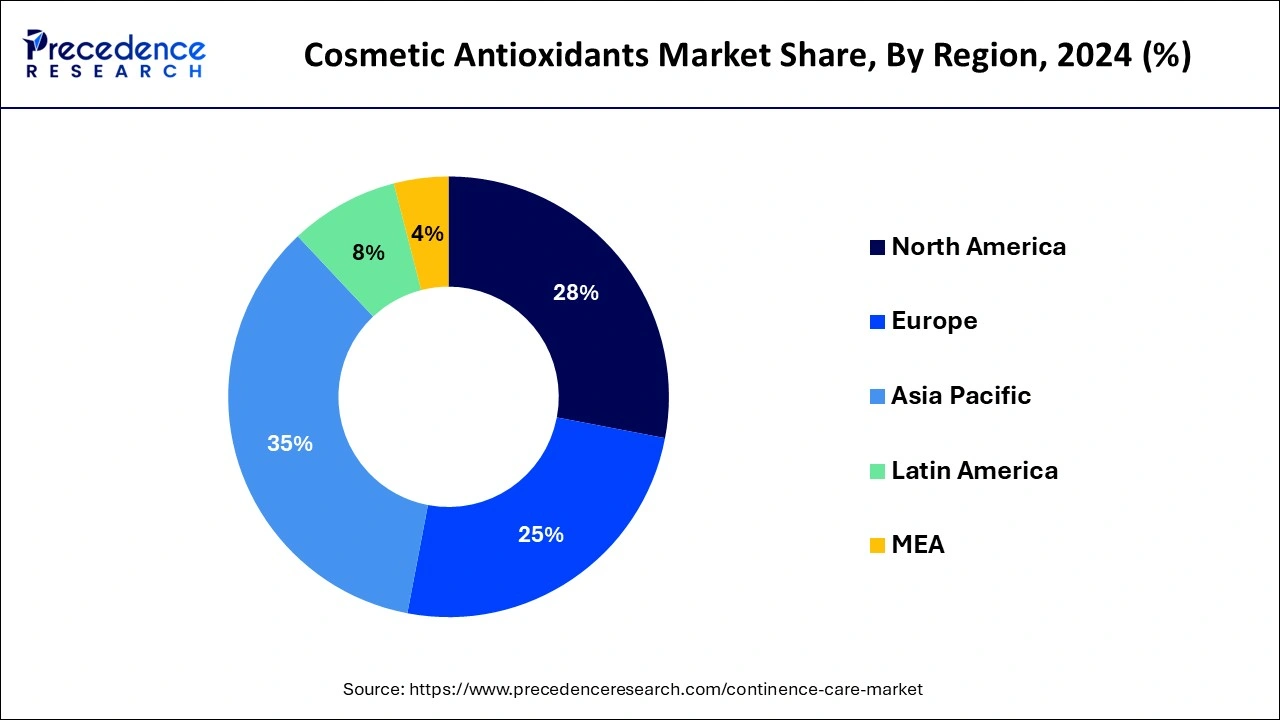
The growing interest in cosmetics increases the popularity of antioxidants. Antioxidants are a popular ingredient in a variety of cosmetic products to enhance healthy and youthful skin. Antioxidants protect the skin’s surface from oxidative damage, which is often caused by the harmful effects of free radicals. Cosmetic antioxidants are the active ingredients that are used in various formulations to manufacture skincare and cosmetics products. They are most commonly found in skin care product formulas due to excellent benefits including anti-aging, anti-inflammatory, UV protection, anti-wrinkle, and moisturizing functions.
Antioxidants come in several different forms, such as Vitamin E, Vitamin A, Vitamin C, flavonoids, polyphenols, beta-carotene, and others. Each of the antioxidants is associated with a unique molecular structure and health benefits. For instance, vitamin C is water-soluble, which offers protection against UV damage, whereas vitamin E is fat-soluble, which helps retain skin moisture. Several dermatological and cosmetic formulations contain fats, fragrances, and oils, which are subjected to auto-oxidation by exposure to air, causing odor and chemical degradation. The use of antioxidants can preserve the formulations and enhance the shelf life of a product.
| Report Coverage | Details |
| Growth Rate from 2025 to 2034 | CAGR of 5.67% |
| Market Size in 2025 | USD 162.29 Million |
| Market Size by 2034 | USD 266.45 Million |
| Largest Market | Asia Pacific |
| Base Year | 2024 |
| Forecast Period | 2025 to 2034 |
| Segments Covered | By Source, By Type, and By Application |
| Regions Covered | North America, Europe, Asia-Pacific, Latin America, and Middle East & Africa |
Increasing adoption of cosmetics products
The rising adoption of cosmetics products around the world is expected to drive the growth of the cosmetic antioxidants market during the forecast period. Cosmetic antioxidants are composed of minerals and vitamins. Gradually, consumers are becoming more conscious regarding the ingredients used in cosmetic formulations and seeking high-quality products. Cosmetics antioxidants assist in protecting skin against environmental stressors such as UV radiation, blue light, and pollution. These stressors often cause oxidative damage to cells, which results in premature aging, hyperpigmentation, and various other skin issues.
Antioxidants play a vital role in neutralizing free radicals by donating electrons, which prevent oxidative damage and promote healthy skin. Additionally, the increasing number of adverse effects related to the use of cosmetics products has fueled the market’s expansion during the forecast period. Thus, the rising use of cosmetics products is expected to supplement the market growth during the forecast period.
High cost
The high cost associated with cosmetic antioxidants are anticipated to hamper the market's growth. The market has also observed a lack of awareness regarding the significance of antioxidants in cosmetics in underdeveloped countries. In addition, strict government regulations and high packaging costs may restrict the expansion of the global cosmetic antioxidants market.
Robust growth of the e-commerce platform
The robust growth of the e-commerce platform is projected to offer lucrative opportunities to the cosmetic antioxidants market during the forecast period. The market has witnessed increasing online purchases of skincare and cosmetics products to grab attractive discounts and value-added services offered by them. Changes in lifestyles increase the purchase of cosmetic products to preserve the attractive appearance and texture and maintain healthy skin. E-commerce offers the availability of a wide range of cosmetics products at an affordable range, which contributes to the market growth of the cosmetic antioxidants market.
The Natural segment dominated the cosmetic antioxidants market with largest share of 43% in 2024 owing to the rising consumption of a wide variety of cosmetic products, which includes butylated hydroxytoluene (BHT), propyl gallate (PG), Tert-butylhydroquinone (TBHQ), and butylated hydroxyanisole (BHA). Synthetic antioxidants enhance the shelf life of a product and provide better color, fragrance, and texture to cosmetic products.
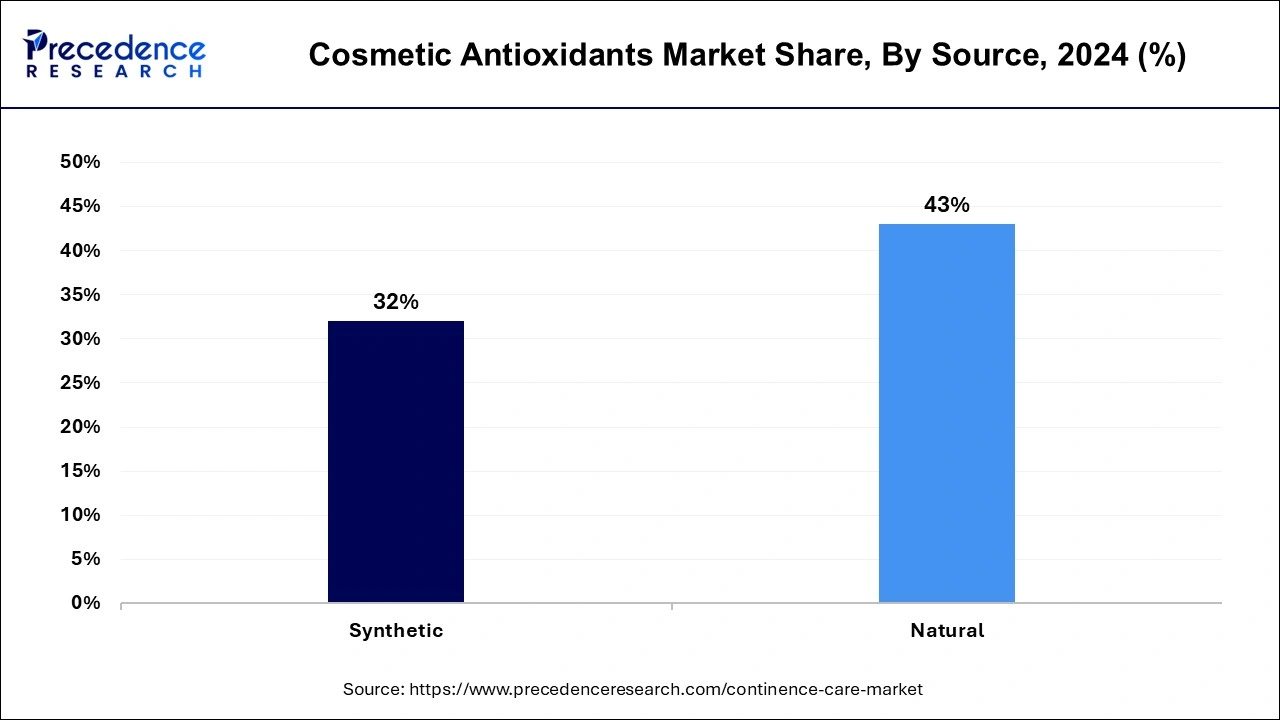
The Synthetic segment is expected to grow at a notable rate in the market during the forecast period. The growth of the segment is driven by the increasing usage of natural antioxidants in cosmetics products, including carotenoids, polyphenols, enzymes, and vitamins due to their anti-aging properties. Premature aging has become a major concern among women, increasing the demand for anti-wrinkle creams and moisturizers.
The vitamins segment had the largest share of the cosmetic antioxidants market in 2024 and is expected to maintain its position throughout the forecast period. The segment's growth is fueled by the increasing use of natural antioxidants as a better alternative to chemically derived synthetic antioxidants. Vitamins can be extracted from plants, fruits, vegetables, and other sources without the need for additional chemicals in their formulation, and they offer several benefits. Vitamin C is a vital nutrient for skin health as it stimulates reactions that lead to collagen production. Additionally, avocados are a rich source of antioxidants and have long been used in facial treatments to nourish dry skin.
The cosmetic antioxidants market is predicted to witness significant growth in the carotenoids segment during the forecast period. This is mainly due to the rising number of skin diseases. Carotenoids act as antioxidants and can help reduce acne, soften the epidermis, and slow down the aging process. Furthermore, they can minimize the effects of photoaging. Beta-carotene and lycopene are two powerful antioxidants that can help alleviate the negative effects of sun damage on the skin, such as DNA damage caused by exposure to UV radiation.
The skin care segment held the dominating share of the cosmetic antioxidants market in 2024. Factors such as growing demand for sunscreens, fairness creams, body lotions, and others. A wide variety of face creams and moisturizers are becoming popular and gaining attention among people who are more conscious about their physical appearance and prevent skin-related diseases. Antioxidants in skincare products help prevent skin damage caused by free radicals, pollution, and other adverse environmental effects. It safeguards the skin surface against oxidative damage, including dryness, itching, infection, and others. Thereby, the consumer's inclination toward antioxidant-based skin care products is expected to influence the segment’s growth positively.
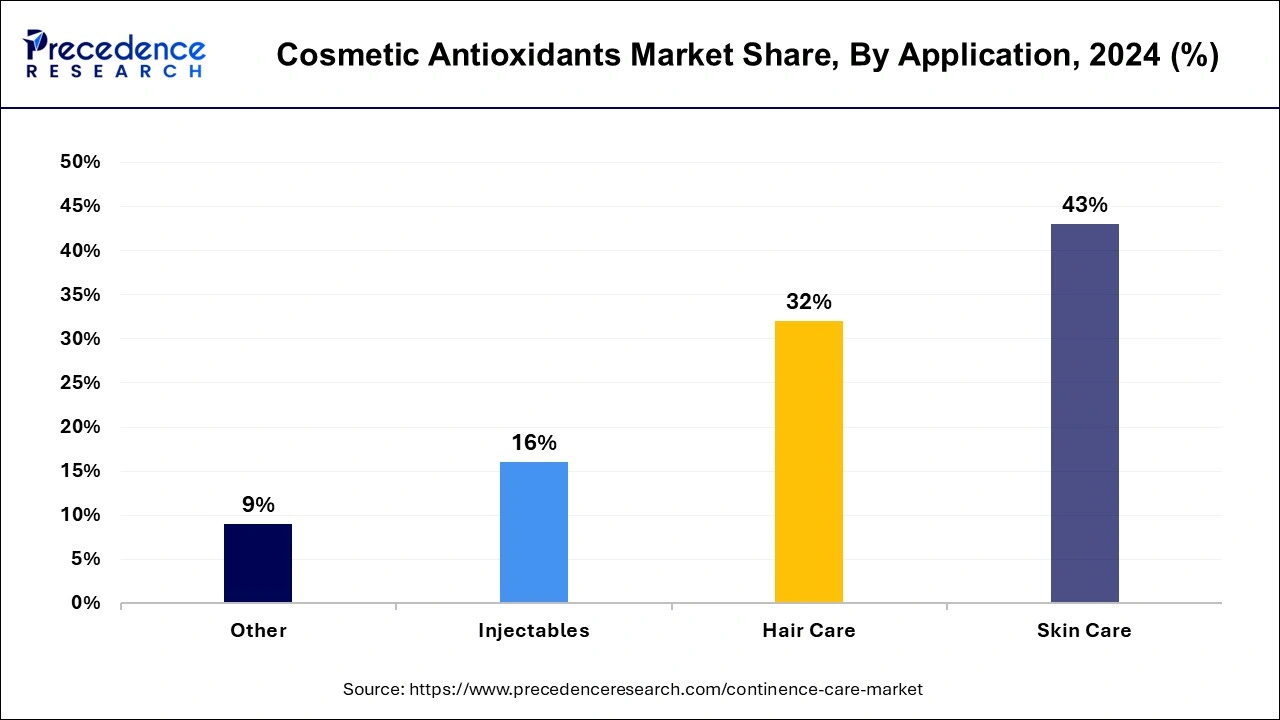
The hair care segment is expected to grow at a notable rate in the upcoming years owing to increasing consumer expenditure on hair care products coupled with growing consciousness concerning aesthetic look. The effects of free radicals may result in frizzy, dry, and brittle hair. Antioxidants help prevent these hair issues. They are protective and useful ingredients in hair care products, as free radicals can damage cellular structures such as lipids, DNA, and proteins.'
By Source
By Type
By Application
By Geography
For inquiries regarding discounts, bulk purchases, or customization requests, please contact us at sales@precedenceresearch.com
No cookie-cutter, only authentic analysis – take the 1st step to become a Precedence Research client
January 2025
December 2024
December 2024
March 2025